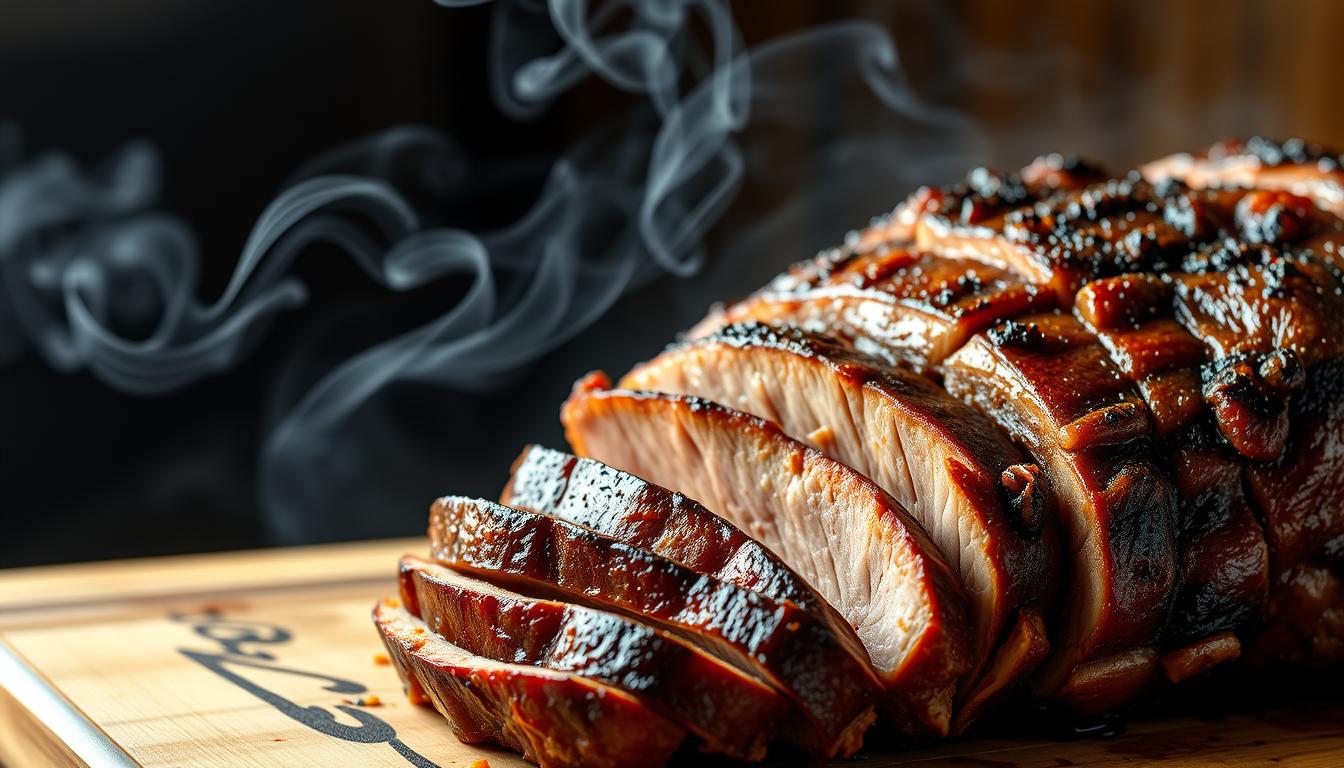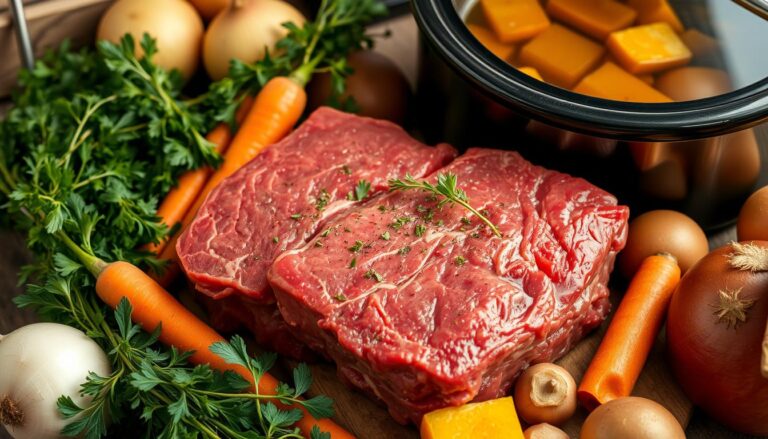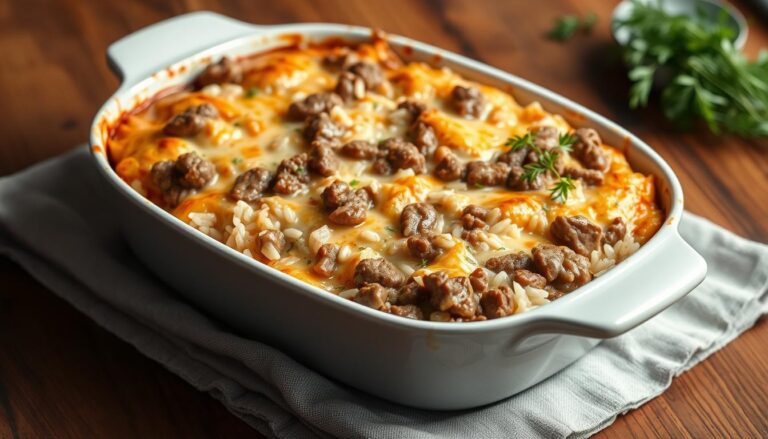Ultimate Best Brisket of Beef Recipe for Mouthwatering Flavor
The smell of a well-cooked brisket can turn a simple meal into a special event. My first time trying a truly amazing brisket was at a family reunion in Texas. My uncle slow-cooked a huge piece of beef that was so tender, it left a lasting memory.
Brisket recipes have a long history in American cooking, mainly in barbecue. This cut from the lower chest of beef needs patience, skill, and knowledge to make a delicious dish. Whether you’re making an oven brisket or trying traditional smoking, mastering this can take your cooking to the next level.
This guide will teach you all about making the best brisket of beef recipe. You’ll learn how to pick the right cut and get that tender, fall-apart texture that makes everyone happy at your dinner.
Table of Contents
Understanding the Art of Brisket Preparation
Exploring brisket means learning about its special traits and cooking methods. This guide will show you how to make a delicious brisket, whether in the oven or other ways.
Brisket is from the cow’s breast area. It has two parts: the flat cut and the point cut. Each part cooks differently.
What Makes a Perfect Brisket Cut
Look for these qualities in a brisket:
- Fat cap thickness between 6-8 millimeters
- Consistent marbling throughout the meat
- Fresh, high-quality beef from reliable sources
The Science Behind Tender Brisket
To slice a brisket right, first understand its makeup. The point and flat muscles need different cooking methods for tenderness.
| Brisket Part | Characteristics | Cooking Recommendation |
|---|---|---|
| Flat Cut | Leaner muscle | Low and slow cooking |
| Point Cut | More marbling | Extended cooking time |
Choosing Quality Meat
Remember, brisket is always beef. Choosing a high-quality cut is key for great results.
“The secret to a perfect brisket lies in understanding its unique muscle structure and cooking it with patience and precision.”
Pro tip: Choose briskets with even marbling, a thick fat cap, and 8-10 pounds for best smoking and flavor.
Essential Equipment and Tools for Brisket Success
Smoking a brisket in a smoker needs special equipment. It can make your cooking better. Whether you’re new or experienced, the right tools are key for a tasty brisket.
Here are the main pieces you’ll need:
- Digital meat thermometer
- Large cutting board (18 x 24 inches recommended)
- Sharp boning knife
- Smoker (offset, pellet, or electric)
- Food-safe spray bottle
- Heat-resistant gloves
- Butcher paper
The Thermoworks Thermapen One is a top choice for a digital thermometer. It helps you keep an eye on the brisket’s temperature. When picking a smoker, think about temperature control, size, and fuel type. Pellet smokers give steady heat, while offset smokers add that smoky taste.
“The right equipment can transform an average cook into a brisket champion.” – Pitmaster Christie Vanover
For beginners, investing in good tools is smart. A meat injector adds moisture to leaner cuts. Water pans keep the brisket moist, making it juicy.
| Equipment | Purpose | Recommended Investment |
|---|---|---|
| Digital Thermometer | Track internal meat temperature | $35-$200 |
| Large Cutting Board | Prep and slice brisket | $50-$150 |
| Quality Smoker | Cook and impart smoky flavor | $300-$1000 |
While great equipment doesn’t guarantee perfect brisket, it helps a lot. It boosts your chances of making a delicious, tender brisket.
Best Brisket of Beef Recipe: Step-by-Step Guide
Cooking a perfect beef brisket in the oven needs patience, skill, and focus. Whether you’re cooking at home or love barbecue, learning to cook beef brisket in the oven can make any meal special.
To make a delicious brisket, start by picking the right cut and knowing how to cook it. Here are the key steps to make a brisket that will wow your family and friends.
Preparing the Meat
Getting ready for a beef brisket in the oven is important. Choose a high-quality brisket, 4-7 pounds, and aim for 6-7 pounds for big groups.
- Trim excess fat, leaving about ⅛ inch fat cap
- Pat the meat dry with paper towels
- Let the brisket get to room temperature before cooking
Creating the Perfect Rub
A tasty rub is key for baking a brisket in the oven. Mix up a simple yet powerful seasoning blend:
- Kosher salt
- Black pepper
- Garlic powder
- Paprika
Cooking Temperature Guidelines
| Cooking Stage | Temperature | Duration |
|---|---|---|
| Initial Searing | 425°F | 1 hour 15 minutes |
| Slow Cooking | 300°F | 2 hours 30 minutes |
| Final Internal Temperature | 205°F | Until reached |
Pro tip: Use a meat thermometer to ensure perfect doneness. The optimal internal temperature for a tender brisket is around 205°F.
“Patience is the secret ingredient in creating a mouthwatering beef brisket.” – BBQ Experts
After cooking, let your brisket rest for at least 1-2 hours before slicing. This step is crucial for tenderness and moisture. It makes your meal delicious and ensures everyone wants more.
Smoking vs. Oven-Baking Methods
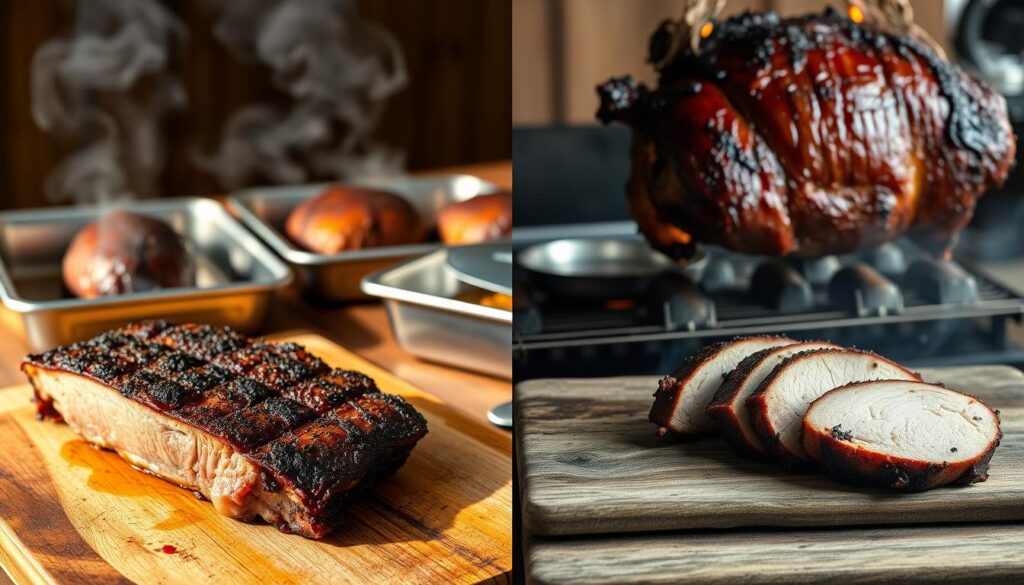
Learning how to cook brisket in the oven opens up a world of tasty options. These methods are as good as traditional smoking. Each has its own benefits for cooking this favorite meat.
Smoking brisket gives it a deep, smoky taste that many love. Cooking techniques differ, but smoking uses slow heat. This makes the meat tender and soft.
“The key to perfect brisket is patience and precise temperature control.”
- Smoking Method:
- Typical cooking time: 8-12 hours
- Temperature range: 225°F to 250°F
- Provides deep, smoky flavor
- Oven-Baking Method:
- More consistent temperature control
- Easier for home cooks
- Shorter preparation time
Oven-baking brisket is easier and quicker. To start, preheat to 275°F. Use a covered roasting pan to keep the meat moist. The low and slow method is key for a tender texture.
For oven-baking tips, use a meat thermometer. Check the meat’s internal temperature. Aim for 200°F in the thickest part for the best tenderness.
The Secret to Perfect Marinade and Seasonings
Crafting the ultimate brisket starts with marinades and seasonings. Your journey to mouthwatering beef brisket begins with the best rubs. These will turn an ordinary cut into a culinary masterpiece.
The secret to a great beef brisket sauce is a balanced spice blend. Professional pitmasters have spent years perfecting this. They aim to enhance the meat’s natural richness.
Classic Spice Combinations That Elevate Flavor
For the best rubs, simplicity is key. Here’s a classic spice blend that will elevate your brisket:
- ½ cup table grind black pepper
- ½ cup Lawry’s seasoning salt
- 2 tablespoons garlic powder
- 2 tablespoons onion powder
- 1 tablespoon Gebhardt’s chili powder
- ½ teaspoon cumin
Marinade Timing and Techniques
For the most flavorful beef brisket sauce, timing is everything. Experts say dry brining for at least 4 hours is best. But 12 hours is even better for deeper flavor.
| Seasoning Aspect | Recommended Amount |
|---|---|
| Dry Rub Quantity | 1/3 to 1/2 cup per brisket |
| Dry Brining Time | 4-12 hours |
| Rub Servings | 60 servings |
“The secret to an unforgettable brisket is in the careful balance of spices and patience during preparation.”
Pro tip: When applying your beef brisket sauce or rub, make sure to cover the whole meat. This creates a flavorful crust. It seals in the meat’s juices and adds a delicious exterior.
Temperature Control and Cooking Times
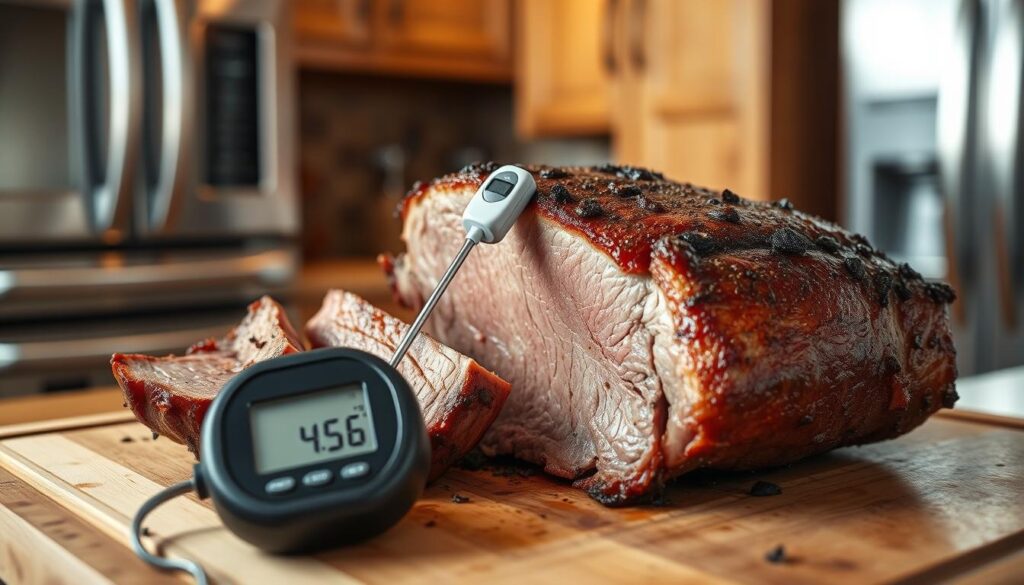
Mastering brisket cooking means keeping a close eye on temperature. The right beef brisket smoking temp is key to that tender, juicy texture. Aim for a smoker temperature of 230°F to 250°F when smoking your brisket.
Knowing the cooking temp is crucial. The brisket’s internal temp journey is interesting. Pitmasters call the “stall” between 150°F and 160°F. Professional smokers say patience is important this phase, as the meat is getting flavorful and tender.
“The secret to perfect brisket is understanding its temperature journey.” – BBQ Experts
- Ideal cooking temperature: 230°F-250°F
- Target temp beef brisket done: 195°F-205°F
- Recommended cooking time: 60-90 minutes per pound
The ideal cooked temperature for brisket is between 195°F and 205°F. At this point, the meat is tender. Use a meat thermometer to check the internal temperature.
Every brisket is different. Meat thickness, smoker consistency, and temperature can change cooking times. Always let your brisket rest for at least an hour after cooking. This ensures it stays moist and flavorful.
The Art of Slow Cooking Brisket
Mastering slow cooking is key to a tender, delicious brisket. It’s all about temperature control, wrapping, and resting.
Monitoring Internal Temperature
Tracking the brisket’s internal temperature is crucial. Aim for a temperature between 250-275°F. Check the brisket’s internal temperature to 165°F during the first smoking phase.
- Start monitoring temperature at 1-hour intervals
- Use a reliable meat thermometer
- Check temperature in the thickest part of the meat
Expert Wrapping Techniques
The Texas Crutch method is a game-changer. Wrap the brisket when it’s around 4-6 hours into cooking, at 150-170°F. Wrapping prevents moisture loss and speeds up cooking.
| Wrapping Material | Pros | Cons |
|---|---|---|
| Aluminum Foil | Fastest cooking | Less bark development |
| Butcher Paper | Breathable, preserves bark | Slightly longer cooking time |
The Crucial Resting Period
Patience is key when cooking brisket. After reaching 190-205°F, let it rest for 1-2 hours. This ensures tenderness and flavor.
“A perfectly rested brisket is the difference between good and extraordinary barbecue.” – Pitmaster Wisdom
Remember, slow and steady wins the race in making the most delicious brisket!
Mastering the Slicing Technique
Slicing a brisket is an art that can make or break your barbecue experience. Learning how to slice a brisket correctly turns a tough cut of meat into a tender, mouthwatering delicacy. The key to success is understanding the grain direction and using the right cutting technique.
The most critical aspect of how to cut a brisket is identifying and slicing against the grain. Meat fibers run in specific directions. Cutting perpendicular to these fibers ensures maximum tenderness. Professional pitmasters recommend a few essential steps when trimming a beef brisket:
- Use a sharp, long knife with a thin blade
- Identify the grain direction before cutting
- Slice against the grain at a consistent thickness
- Aim for slices approximately 1/4 inch thick
Pro tip: The grain direction can change between the flat beef brisket and point sections, so pay close attention!
When trimming a beef brisket, you’ll want to observe two distinct sections: the flat and the point. Each section may require slightly different slicing techniques to maintain optimal tenderness.
| Brisket Section | Slice Thickness | Cutting Technique |
|---|---|---|
| Flat | 1/4 inch | Consistent, against the grain |
| Point | 1/4 inch | Adjust for changing grain direction |
Professional chefs recommend using a sharp slicing knife and taking your time to ensure each cut is precise. Remember, the goal is to create tender, beautiful slices that showcase your barbecue skills.
Sauce and Serving Suggestions
Crafting the ultimate beef brisket experience is more than just cooking. The right sauce can turn a good dish into an extraordinary one. Texas brisket lovers know that choosing the perfect sauce is an art.
Classic Sauce Pairings
Your beef brisket sauce is crucial. Traditional Texas brisket sauces have a few key traits:
- Tangy tomato-based foundation
- Balanced sweet and spicy notes
- Thin consistency for easy drizzling
Modern Serving Ideas
Looking for the best brisket near me? You’ll find new ways to serve it:
- Brisket tacos with fresh salsa
- Pulled brisket sandwiches
- Brisket-topped loaded nachos
“A great sauce complements, never overwhelms the beautiful meat.” – BBQ Pitmaster
Nutrition and Serving Tips
Remember these nutritional tips when serving:
- Recommended serving size: ½ pound cooked brisket
- Calories per serving: 669 kcal
- Protein: 65g
Pro tip: Serve your beef brisket sauce on the side. This lets guests customize their dish and enjoy the meat’s natural flavors.
Storage and Reheating Tips
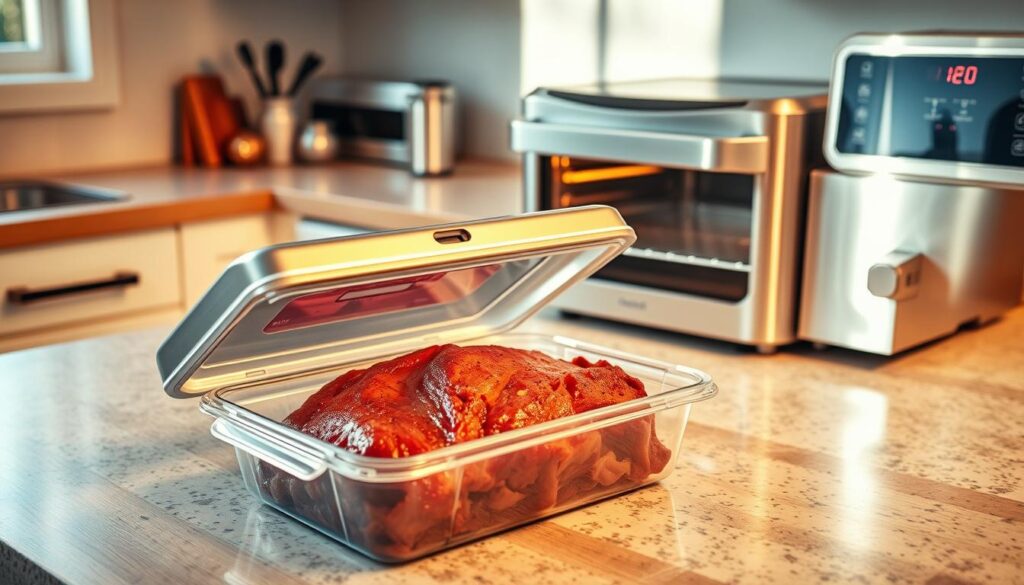
Keeping your brisket’s flavor fresh is key. Knowing how long cooked beef can sit out is important for safety and taste. The USDA says to store leftover brisket in the fridge for up to 4 days for the best taste.
“Low and slow” is the golden rule for both cooking and reheating brisket.
When planning your meal, remember that brisket serves 6 to 8 people. A 4-pound brisket is great for groups, offering enough for everyone.
Storage Methods
- Refrigerator storage: Up to 4 days in an airtight container
- Freezer storage: Up to 2-3 months when properly wrapped
- Vacuum-sealed brisket can last up to 18-24 months in the freezer
Reheating Techniques
| Method | Temperature | Time |
|---|---|---|
| Oven | 250°F | 45-60 minutes |
| Smoker | 225°F | 1-2 hours |
| Sous Vide | 140°F | 1-2 hours |
Pro tip: Always reheat brisket to 165°F to keep it safe. Don’t use the microwave, as it can dry out the meat. Add a splash of beef broth to reheat it to keep it juicy.
By using these storage and reheating tips from expert grill masters, your brisket will taste as good as the day you made it.
Conclusion
Learning where beef brisket comes from is key to your barbecue journey. It’s found in the cow’s lower chest, under the first five ribs. With the right cooking, it goes from tough to tender.
Whether you’re looking for the best brisket or cooking your own, you now know more. This knowledge will boost your cooking skills.
Your brisket adventure is more than cooking. It’s about mastering a long-standing tradition. You’ve learned how to pick the best USDA grade and how to season and smoke it.
Knowing where brisket is on a cow is important. It helps you prepare a dish that tastes amazing.
When cooking brisket, patience and precision are essential. A 10-16 pound packer brisket needs 10-12 hours of cooking. You also need to watch the temperature and let it rest.
Your new skills will make a tender, flavorful brisket. It will impress everyone, making any meal special.
Keep trying new things with different woods, rubs, and techniques. Each brisket is a chance to get better and make something delicious. Enjoy the art of barbecue and become a brisket master.

